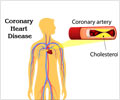Adults aged 32 - 46 years with Coronary Artery calcium experienced a 5-fold increase in CHD events and 3-fold increase in CVD events.

- Coronary artery calcium (CAC) is a non-invasive measure of coronary artery disease.
- CAC increased the risk of fatal and //non-fatal coronary heart disease events by 5-fold in adults.
- It was unknown if the presence of CAC by midlife increases the risk of CHD clinical events during the next decade.
- The finding emphasizes the need for reduction of risk factors and primordial prevention beginning in early life.
John Jeffrey Carr, M.D., M.Sc., of the Vanderbilt University Medical Center, Nashville, Tenn., and colleagues conducted follow-up of CARDIA participants who had CAC measured 15, 20, and 25 years after entering the study. At year 15 of the study among 3,043 participants (average age, 40 years), 10 percent had CAC.
Participants were followed up for 12.5 years, with 57 incident CHD events (fatal or nonfatal heart attack, acute coronary syndrome without heart attack, coronary revascularization, or CHD death) and 108 incident CVD events (CHD, stroke, heart failure, and peripheral arterial disease) observed.
After adjusting for demographics, risk factors and treatments, those with any CAC experienced a 5-fold increase in CHD events and 3-fold increase in CVD events.
"Whether any kind of general screening for CAC is warranted needs further study, although we suggest that a strategy in which all individuals aged 32 to 46 years are screened is not indicated. Rather, a more targeted approach based on measuring risk factors in early adult life to predict individuals at high risk for developing CAC in whom the CT scan would have the greatest value can be considered.”
Reference
- John Jeffrey Carr et al., Presence of coronary artery calcium among younger adults associated with increased risk of fatal heart, JAMA Cardiology (2017).















